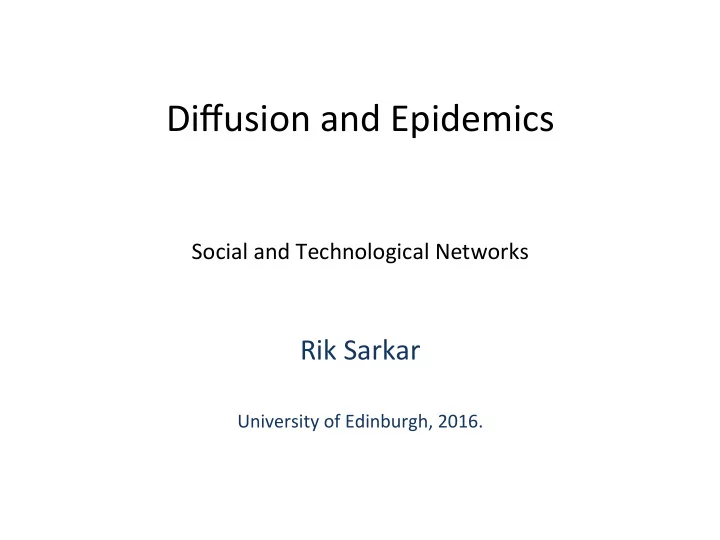

Diffusion and Epidemics Social and Technological Networks Rik Sarkar University of Edinburgh, 2016.
Spread of diseases • PaGern depends on network structure • e.g. spread of flu • Network of people • Network of airlines • Different from idea/innovaJon contagion – Does not need a “decision” – Does not need mulJple support • InfecJous disease passes easily with some probability
• Suppose everyone meets k new people and infects each with probability p • That is, they infect R = kp people on average
• If p is high • The disease will persists through rounds • If p is low, it will die out aOer some rounds
Property • When R > 1 number of infected people keeps increasing – Outbreak • When R < 1 Number of infected people decreases – Disease dies out • Phase transiJon at R = 1 • assuming there are enough “new” people supply to meet • Generally true in the iniJal stages
• Around R = 1: small efforts can have large effects on epidemic – Awareness causing slight decrease in p – QuaranJne/fear causing slight decrease in k
SIR Model • SuscepJble (iniJally) • InfecJous (aOer being infected) – While InfecJous, it can pass disease to each neighbor in each step with prob. p • Removed (aOer given duraJon as InfecJous) – Immune/dead
SIS model • No “Removed” state. SuscepJble follows InfecJous
SIRS model • SuscepJble • InfecJous • Recovered (immune) • SuscepJble
SIRS oscillaJons in WaGs-Strogatz Small worlds • Nodes connected to few nighbors on a ring • FracJon c of links modified to connect to random nodes
Epidemic or gossip algorithm • Emulates the spread of epidemic or a rumor in a network • A node speaks to a random neighbor to spread the rumor message • Useful for spreading informaJon in computer networks
Spreading a message via gossip • Complete graph: Anyone can call anyone • Problem: One node has a message or rumor to spread. How does it spread it to all nodes in the network? • Calling everyone will take O(n) rounds. • AOer first round, nodes with the rumor can help – But how do you avoid collision?
Spreading a message via gossip • Complete graph: Anyone can call anyone • Problem: One node has a message or rumor to spread. How does it spread it to all nodes in the network? • Strategy: In each round, anyone with the rumor calls one random node and passes the rumor
Theorem • Everyone gets the message in O(log n) rounds • Idea: • n/3 nodes get the message in log n rounds – Current number of infected nodes m < n/3 – Probability that a call goes to a new node is at least 2/3 • Number of calls to new nodes: 2m/3 – Probability of a collision at the new node is 1/(n-m) – possible pairs for collision O ( m 2 ) – Max possible collisions: • Number of newly infected nodes at least
• while m < n/3 – m grows to m(1 + 5/12) = 17m/12 every round – m grows to n/3 in O(log n) rounds • AOer m> n/3 – Probability that a node is not called in 1 round is – Probability that 1 or more nodes are not called aOer O(log n) rounds – Less than , where c depends on the constant in the O
• See Kempe 11, chapter 9.
• In a computer network (imagine wireless network) • Spreading a piece of informaJon • Naive method: A flood: a node calls all its neighbors to send message • Wasteful: since many nodes can have common nearby neighbors, this wastes messages • BeGer to do it as one neighbor per round • SJll spreads slowly… • At least √n rounds in a grid of n nodes
Geographic gossip in wireless networks • Imagine nodes on a plane • Instead of only sending messages to neighbors • Send to nodes at random (assume there is some rouJng mechanism in place) • Easily reaches far away nodes • Faster: O(log n) rounds: O(n log n) messages • but the rouJng costs more messages: – √n hops on average per message – (n√n) log n total transmissions
Spread in small world distribuJons • Instead send message to a random node – Picked according to a small world-like distribuJon – Picking a node at distance d with probability 1/d 3 – Note the slight difference in exponent (3 instead of 2) – Short paths are more common in these distribuJons – The average message cost is O(poly(log n)) – SJll there are enough long messages spreading the message to far away regions • Kempe, Kleinberg, Demers; SpaJal gossip and resource locaJon protocols STOC 2001
Advantages of gossip • Simple to implement • Robust algorithm – A node failure does not stop the computaJon – Easy to add nodes to the system – At the cost of a logarithmic factor of increased costs
Averaging gossip • Suppose the nodes all have a “value” • And we wish to compute a linear funcJon of these values • E.g. the average
• The push-sum protocol – In every round – Every node takes a fracJon of its value and sends to a random neighbor – It adds all received values to its current value • The pairwise averaging protocol – In every round, a node talks to one other random neighbor – Both nodes set their values to the average of the two
Gossip averaging protocols • On a complete graph – Both protocols converge to the average fast – O(log n) rounds • On small world graphs/small world distribuJons – Convergence not known
Recommend
More recommend